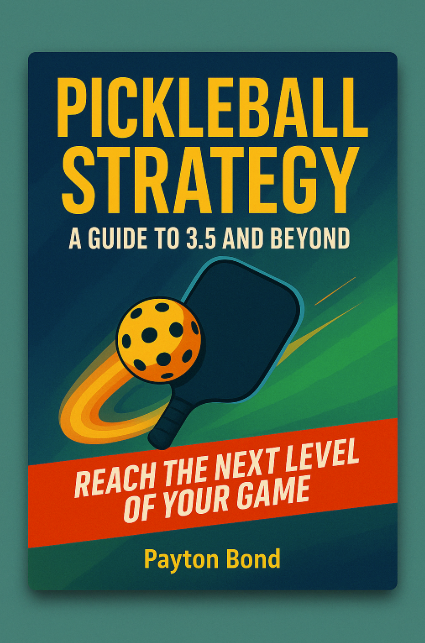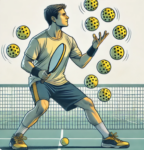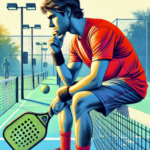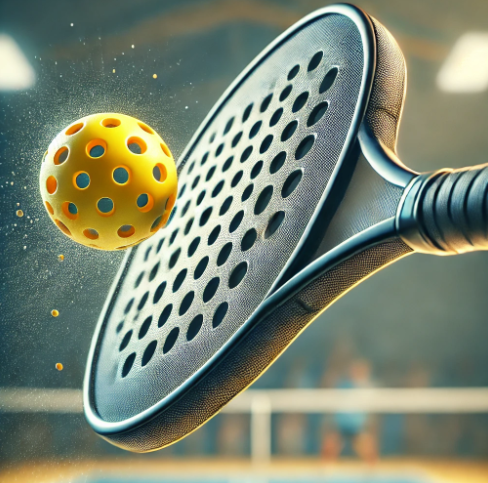
Pickleball Spin Shots
As your game progresses and you are hitting basic shots well, you can start to apply more spin to your shots. Spin can be added to forehand and backhand shots, this post reviews how to add different types of spin to your forehand shots.
As mentioned previously, good execution of all of this will come with playing, practice, coaching from others and review of on-line tutorials and videos.
Drive with Top Spin
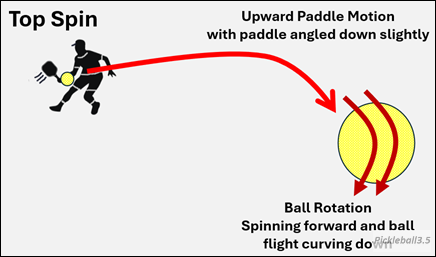
As mentioned, the forehand drive shot is the most common and natural shot in pickleball and is the first stroke you will use when you step on the court. Most players will have a stroke that may hit the ball neutrally, meaning it will be a flat shot without much spin. Some players, especially those with a tennis background will have a natural Forehand shot with top spin. Adding top spin to your forehand shot is very beneficial in pickleball and is good to learn as you practice your forehand.
Preferred Grip
Eastern Forehand Grip. Power, control and topspin.
Stance and Preparation
- Stand with your feet shoulder-width apart, knees slightly bent, and body turned sideways to the net.
- Keep your paddle below the ball level as you prepare to swing. Your non-dominant hand should point towards the ball to help with balance and alignment.
Swing Technique
- Draw the paddle back and down, positioning it behind your body. The paddle face should be slightly closed (tilted forward).
- Contact the ball just in front of your body. The contact point should be low to high, meaning you hit the ball at a low point and brush it upwards.
- As you hit the ball, brush the paddle upward against the back of the ball. This motion is crucial for hitting a topspin shot. The more you brush up, the more topspin you will create.
- Follow through high and across your body. Your paddle should finish above your shoulder on the opposite side of your body (for right-handers, the paddle should finish above the left shoulder and vice versa for left-handers).
Key Points to Remember
- Keep the paddle face slightly closed to help generate the spin. A closed paddle face is tilted downward, with the hitting surface facing more towards the ground.
- Emphasize a low to high swing path to create the necessary brushing action on the ball.
- Accelerate through the ball, using a controlled and smooth motion. Too much speed can make the shot difficult to control.
Benefits of a Topspin Shot
- Topspin allows you to hit the ball harder while keeping it in play due to the downward dip caused by the spin.
- The ball will bounce higher and faster, making it more difficult for your opponent to return. The spin of the ball will cause the ball to move upward off your opponent’s paddle and if they don’t adjust for this, they may pop up the shot or hit it high and out of play.
- Topspin provides a greater margin of error as the ball tends to dip into the court rather than sailing long.
Forehand Back Spin/ Cut Shot
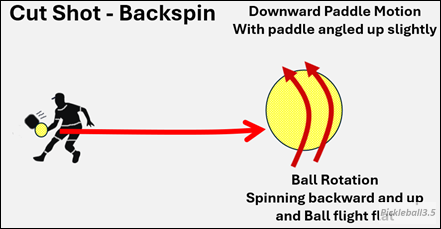
A forehand Cut shot with backspin in pickleball is a technique where the ball is struck in such a way that it spins backward as it travels towards the opponent. This spin causes the ball to slow down and stay low upon bouncing, making it difficult for the opponent to return. Here’s a detailed description of how to execute a cut shot with backspin:
Preferred Grip
Continental Grip. Paddle is in neutral position. Easier to position for shot.
Stance and Preparation
- Position your feet shoulder-width apart with knees slightly bent. Stand sideways to the net with your non-dominant shoulder pointing towards your target.
- Hold your paddle high and slightly open (tilted upward), ready to slice under the ball.
Swing Technique
- Take the paddle back slightly high, positioning it above the level of the ball. Your paddle face should be open (tilted upward).
- Contact the ball in front of your body. The contact point should be above and behind the ball.
- As you hit the ball, slice down and through the bottom part of the ball. This downward cutting motion is crucial for generating backspin. The paddle should move from high to low.
- Your follow-through should be short and downward. The paddle should finish below the point of contact. Keep the follow-through controlled and compact.
Key Points to Remember
- Keep the paddle face open to help generate the necessary backspin.
- Emphasize a high to low swing path to slice under the ball effectively.
- Focus on control rather than power. A smooth, controlled swing will produce more effective backspin.
Benefits of a Cut Shot with Backspin
- The ball will bounce lower and slower, making it difficult for your opponent to handle. When the ball makes contact with your opponent’s paddle it will move downward because of the back spin causing the ball to go lower than expected and if not adjusted for properly the shot will end up in the net.
- Backspin provides better control over the ball, allowing you to place it precisely where you want.
- A cut shot can disrupt your opponent’s rhythm, especially if they are used to faster, topspin shots.
Side Spin shots
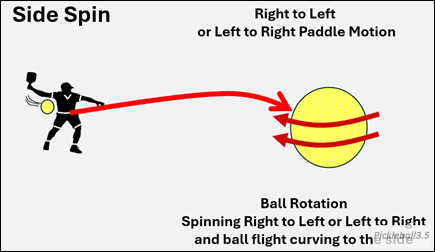
A side spin shot in pickleball involves hitting the ball in such a way that it spins sideways as it travels towards your opponent. This spin causes the ball to curve in the air and can make it more difficult for your opponent to anticipate and return the shot. Here’s a detailed description of how to execute a side spin shot:
Preferred Grip
Continental Grip. Paddle is in neutral position. Easier to position for shot.
Stance and Preparation
- Position your feet shoulder-width apart with knees slightly bent. Stand sideways to the net with your non-dominant shoulder pointing towards your target.
- Hold your paddle out to the side, keeping it at waist level. Your paddle face should be slightly open (tilted upward).
Swing Technique
- Take the paddle back to the side, positioning it slightly behind your body. Your paddle face should be slightly open.
- Contact the ball to the side of its center, brushing it either from left to right or right to left depending on the desired spin direction.
- As you hit the ball, brush it sideways with the paddle face. This brushing motion is crucial for generating side spin. For right-handers, brushing from left to right will create right-side spin, and brushing from right to left will create left-side spin.
- Your follow-through should be in the direction of the spin. If you brushed left to right, your paddle should follow through in that direction, and vice versa. The follow-through should be smooth and controlled.
Key Points to Remember
- Keep the paddle face slightly open to help generate the side spin.
- Emphasize the sideways brushing motion to effectively impart spin on the ball.
- Focus on control rather than power. A smooth, controlled swing will produce more effective side spin.
Benefits of a Side Spin Shot
Adding spin can be especially effective on the return of serve as it complicates the 3rd shot from your opponent. If your opponent will use a 3rd shot drop they need to account for the spin when executing the delicate drop shot.
The ball will curve in the air, making it harder for your opponent to predict and return.
The ball can bounce unpredictably upon landing, further challenging your opponent’s ability to return it.
Adding side spin shots to your game can make you a more versatile and unpredictable player.
Summary of Pickleball Spin Shots
Mastering spin shots in pickleball elevates your game by adding variety, precision, and unpredictability to your strokes. While basic shot execution is essential, learning to apply topspin, backspin, and side spin can give you a competitive edge.
Hi everyone,
This new guide is based on my Facebook posts and content from Pickleball35.com.
I’ve compiled it here to make it easier to follow—and I update it often.
Hope it’s helpful out there.
— Payton Bond
Author at Pickleball35.com

👤 Follow Payton Bond
Stay connected to Payton Bond and explore more content and updates on Facebook.

